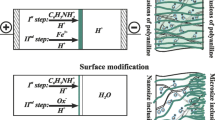Abstract
Changes in the conducting and hydrophilic properties of composites MF-4SC/polyaniline (PAni) under conditions of prolonged synthesis have been studied. A maximum of PAni content of about 0.20 by weight, which can be incorporated into the matrix of MF-4SC under these conditions of synthesis, is determined. Percolation behavior of electrical conductivity of the composites after drying was observed. The conductivity of PAni salt inside MF-4SC was estimated within the frames of the percolation model. Using the fibrous cluster model of the membrane and the conductivity data on individual PAni, theoretical assessment of the electrical conductivity of nanocomposite MF-4SC/PAni has been performed. Reasons for a significant reduction in the conductivity of PAni during its integration into the structure of the initial matrix were discussed. A scale of membrane conductivity, reflecting changes in the electrical conductivity of composites at various stages of synthesis, was drawn.







Similar content being viewed by others
References
Inzelt G (2011) Rise and rise of conducting polymers. J Solid State Electrochem 15:1711–1718
Tan S, Belanger D (2005) J Phys Chem B 109:23480–23490
Berezina NP, Kubaisy AA-R, Timofeev SV, Karpenko LV (2007) J Solid State Electrochem 11:378–389
Berezina NP, Kononenko NA, Sytcheva AA-R, Loza NV, Shkirskaya SA, Hegman N, Pungor A (2009) Electrochim Acta 54:2342–2352
Pud A, Ogurtsov N, Korzhenko A, Shapoval G (2003) Prog Polym Sci 28:1701–1753
Bhadra S, Khastgir D, Singha NK, Lee JH (2009) Prog Polym Sci 34:783–810
Compan V, Molla S, Sytcheva AA-R, Berezina NP, Suarez K, Solorza O, Riande E (2009) ECS Trans 25:645–658
Peighambardoust SJ, Rowshanzamir S, Amjadi M (2010) Int J Hydrogen Energy 35:9349–9384
Protasov KV, Shkirskaya SA, Berezina NP, Zabolotskii VI (2010) Russ J Electrochem 46:1131–1140
Sapurina IYU, Kompan ME, Malyshkin VV, Rosanov VV, Stejskal J (2009) Russ J Electrochem 45:697–706
Berezina NP, Kononenko NA, Dyomina OA, Gnusin NP (2008) Adv Colloid Interf Sci 139:3–28
Ogumi Z, Toyama K, Takehara Z (1992) J Membr Sci 65:205–212
Sycheva AA-R, Falina IV, Berezina NP (2009) Russ J Electrochem 45:108–115
Nekrasov AA, Ivanov VF, Vannikov AV (2001) Electrochim Acta 46:3301–3307
Berezina NP, Karpenko LV (2000) Colloid J 62:749–757
Aoki K, Kawaguchi F, Nishiumi T, Chen J (2008) Electrochim Acta 53:3798–3802
Jang J, Bae J, Lee K (2005) Polymer 46:3677–3684
Kirkpatrick S (1971) Phys Rev Lett 27:1722–1725
McLachlan DS, Blaszkiewicz M, Newnham RE (1990) J Am Ceram Soc 73:2187–2203
Stejskal J (2002) Pure Appl Chem 74:857–867
Berezina NP, Chernyaeva MA, Kononenko NA, Dolgopolov SV (2011) Membr Membr Technol 1:37–45, in Russian
Scher H, Zallen R (1970) J Chem Phys 53:3759–3761
Hsu C-H (1991) Synth Met 41–43:671–674
Jackowska K, Bieguński AT, Tagowska M (2008) J Solid State Electrochem 12:437–443
Falina IV, Berezina NP (2010) Polymer Sci B 52:244–251
Huanga QM, Zhanga QL, Huanga HL, Li WS, Huanga YJ, Luoc JL (2008) J Power Sources 184:338–343
Gnusin NP, Berezina NP, Kononenko NA, Dyomina OA (2004) J Membr Sci 243:301–310
Acknowledgements
This work has been financially supported by the Russian Foundation for Basic Research (grant no. 10-08-00758-a). Also, this work was carried out as part of the TAMOP-4.2.1.B-10/2/KONV-2010-0001 project with support by the European Union and the European Social Fund. The authors would like to express their gratitude to Dr. S.V. Timofeev (Plastpolymer Plc., St. Petersburg, Russia) for the MF-4SC membrane samples supplied and to Professor V.I. Roldugin of the Institute of Physical Chemistry and Electrochemistry of the Russian Academy of Sciences for the valuable discussions.
Author information
Authors and Affiliations
Corresponding author
Rights and permissions
About this article
Cite this article
Falina, I.V., Berezina, N.P., Sytcheva, A.AR. et al. Effects of mixed conductivity of nanocomposite membranes MF-4SC/PANI. J Solid State Electrochem 16, 1983–1991 (2012). https://doi.org/10.1007/s10008-011-1589-z
Received:
Revised:
Accepted:
Published:
Issue Date:
DOI: https://doi.org/10.1007/s10008-011-1589-z



